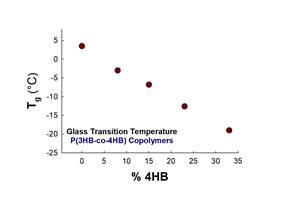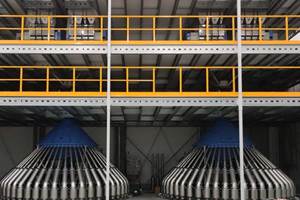Air-Ring Upgrades Get Film Processor Quickly Up to Spec
PolyExpert’s trials lead to installation of three new air rings and one digital IBC control to speed changeovers and reduce scrap.
For blown-film processors serving high-end film markets, quality and the agility to shift quickly from one product to another generally trump line speed. While suppliers of blown-film extrusion equipment are developing complete engineered systems to provide just such performance, in some cases a far less costly investment in a new component or two can generate comparable results.
That’s been the experience of PolyExpert Inc., Laval, Quebec, which bills itself as Canada’s largest non-integrated polyethylene film processor (meaning it doesn’t compete with its customers). The firm was founded in 1979 by Gilles and Ghislaine Plante and to this day remains a family-owned and operated business. Its 75,000 ft² plant employs 120 people; 15 film lines run around the clock. Capacity is split between single- and three-layer structures and includes two high-stalk lines for HMW-HDPE.
PolyExpert initially focused on producing converter film, recalls David Douse, general manager. Over the years, however, it has diversified and now produces films in gauges from 0.4 to 6 mil for a wide range of applications, among them lamination sealant films; agricultural mulch films; bags for bread, diapers, ice, and courier applications; as well as rollstock for vertical and horizontal form-fill-seal, frozen food, and bottle sleeves. Layflat widths range from 18 to 90 in.
When equipment enhancements are needed, PolyExpert will either buy a complete new system or look to upgrade an existing line with critical new-generation components. Last year, it evaluated various ways to improve film quality on three of its older lines. “Our goal is to produce the highest-quality film from all of our lines,” notes Douglas Lord, v.p. of operations. “On three of our lines that are about 10-years old, we evaluated new air-ring technology,” Lord recalls. “The air rings on these particular lines—7, 12, and 14 in.—were standard designs, and we wanted to upgrade to a system that offered automatic gauge control.” PolyExpert brought in several air rings as part of an evaluation process, and at the end settled on three new dual-lip External Gauge Control (EGC) units supplied by Addex Inc., Stoughton, Mass.
The EGC air ring is equipped with horizontally sliding teeth that adjust the air flow through the radially located vanes in the air ring’s plenum, causing preferential cooling on the outside of the bubble. A circuit board inside the air ring converts the mapped thickness profile into instructions for the scanning actuator, which slides a multitude of fingers (120 to 252, depending on air-ring size) in or out as needed, to open or close the airflow channels. Film thickness variation is corrected by the automatic adjustment of the airflow through the air ring’s vanes.
“The really important issue for us was to select an air ring that allowed us to hit our target gauge quickly,” states Lord. “With all the air rings we looked at, the throughput rates we were getting were about the same. But the factor that swayed us toward the EGC was the adjustment speed. We make a lot of different products on the same line, so what’s important to us is to reduce setup times and really tighten the time it takes to produce commercial-quality film, which reduces scrap rates.” Compared with its previous air rings, the Addex EGC provided a 50% improvement in thickness control for all products on all three lines, Lord states.
One of the three EGC-equipped lines is also furnished with Addex’s Digital Internal Bubble Cooling (DIBC) system, which is said to deliver the fastest reaction time in the industry to ensure precise bubble control, helping processors to speed product changeovers and significantly reduce scrap. The five-sensor system features a high-speed, servo-controlled air-regulation valve that performs split-second corrections in bubble size (up to 20 adjustments per second). Users reportedly have switched from a 40-in. layflat to a 60-in. layflat in seconds instead of the minutes it took with the previous system.
All told, PolyExpert invested about $150,000 per line on the upgraded components, significantly less than it would have cost to buy just one complete new line. Lord says the company expects to buy one or two more EGC systems this year.
Related Content
Breaking the Barrier: An Emerging Force in 9-Layer Film Packaging
Hamilton Plastics taps into its 30-plus years of know-how in high-barrier films by bringing novel, custom-engineered, nine-layer structures resulting from the investment in two new lines.
Read MoreFormulating LLDPE/LDPE Blends For Abuse–Resistant Blown Film
A new study shows how the type and amount of LDPE in blends with LLDPE affect the processing and strength/toughness properties of blown film. Data are shown for both LDPE-rich and LLDPE-rich blends.
Read MoreFilm Extrusion: Boost Mechanical Properties and Rate of Composting by Blending Amorphous PHA into PLA
A unique amorphous PHA has been shown to enhance the mechanical performance and accelerate the biodegradation of other compostable polymers PLA in blown film.
Read MoreFilm Processor Automates Complex Resin Management, Blending & Distribution System
Polipak of Poland moves to BlendSave system to support sustainability and Industry 4.0 objectives.
Read MoreRead Next
Troubleshooting Screw and Barrel Wear in Extrusion
Extruder screws and barrels will wear over time. If you are seeing a reduction in specific rate and higher discharge temperatures, wear is the likely culprit.
Read MoreAdvanced Recycling: Beyond Pyrolysis
Consumer-product brand owners increasingly see advanced chemical recycling as a necessary complement to mechanical recycling if they are to meet ambitious goals for a circular economy in the next decade. Dozens of technology providers are developing new technologies to overcome the limitations of existing pyrolysis methods and to commercialize various alternative approaches to chemical recycling of plastics.
Read MoreLead the Conversation, Change the Conversation
Coverage of single-use plastics can be both misleading and demoralizing. Here are 10 tips for changing the perception of the plastics industry at your company and in your community.
Read More


























